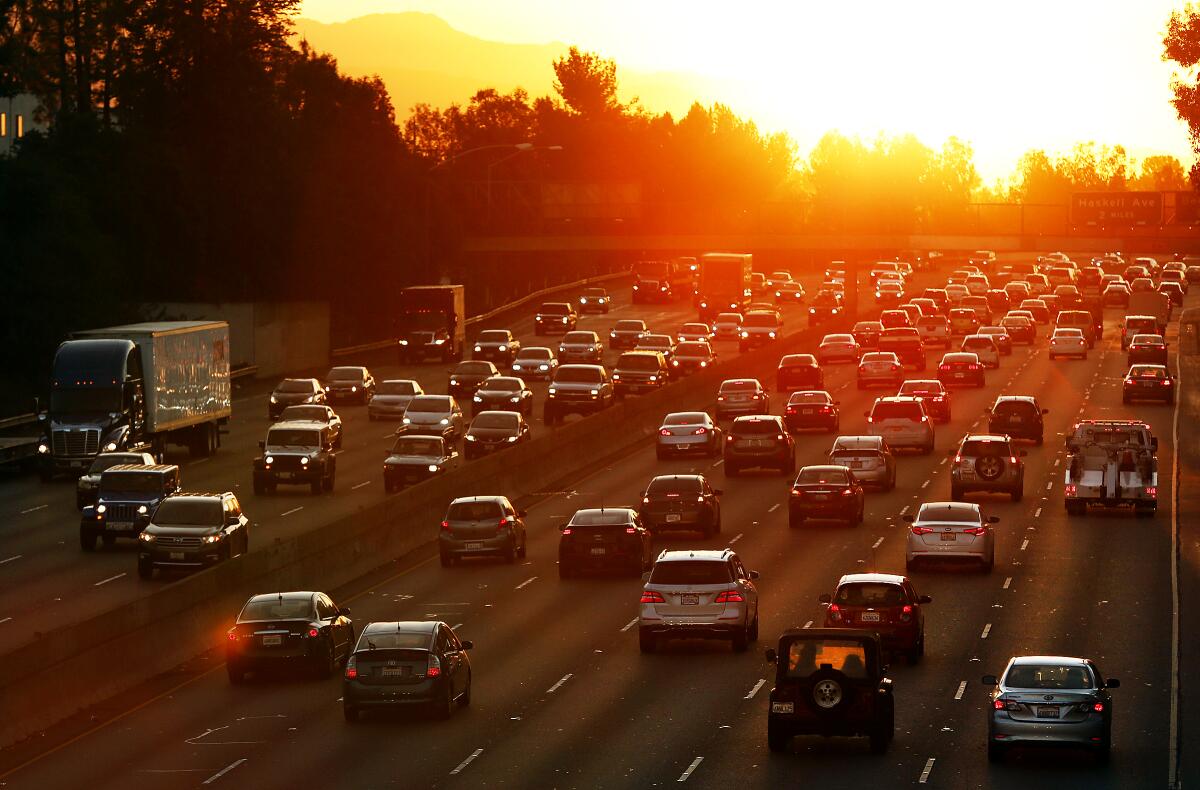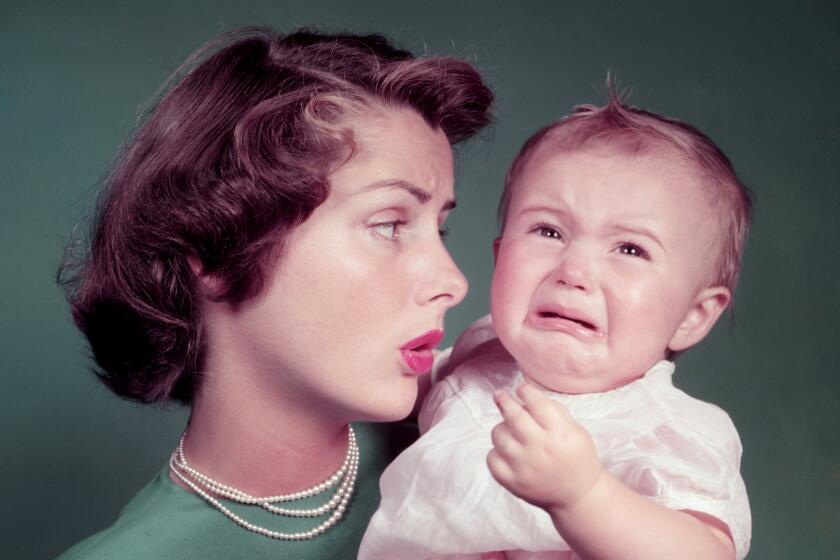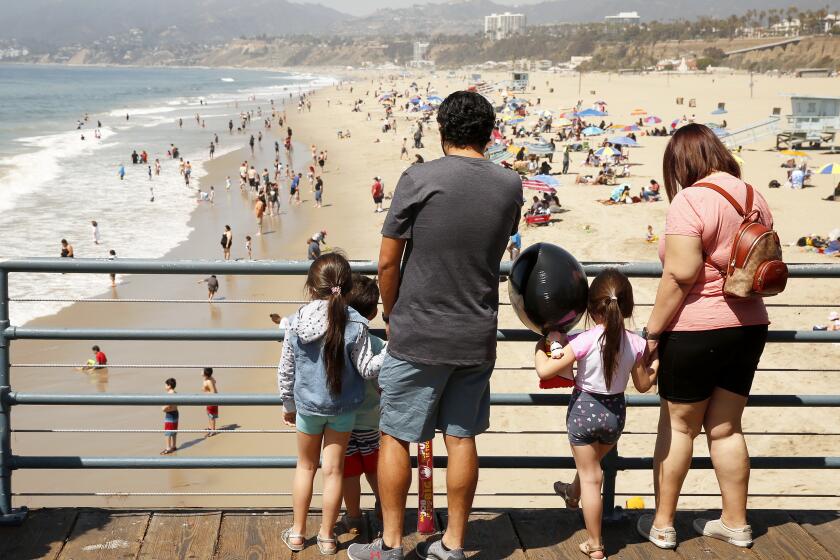Column: If people are really leaving L.A. in droves, why is the traffic still so terrible?

- Share via
According to the most recent census, California’s population decreased by 500,000 in the last two years, with Los Angeles County accounting for a little more than half that loss. (And this was before Gustavo Dudamel announced he was deserting us for New York.)
The state’s growth rate has been declining for years, but 2021 was the first year that saw the population fall, by 0.91%, a trend that continued in 2022 (0.29%). The drop has cost California a congressional seat and put us fourth in terms of net population seepage — behind only New York, Illinois and Louisiana.
To add insult to injury, Texas and Florida experienced net gains of residents during this time, and some of them actually came from California. I’d like to believe the recent transplants are hoping to turn a few red states purple, but that doesn’t seem likely.
No, the reasons appear to be the obvious ones, including the dearth of affordable housing, the high cost of living, the fires, the drought, crime, the absence of anything approaching a decent crab cake. But what I really want to know is: Why, with more than 270,000 fewer people in L.A. County, does it still take me two freaking hours to travel from Santa Monica to La Crescenta on a weekday afternoon?
If this county is hemorrhaging people, why can I never find street parking in Los Feliz or get In-N-Out without waiting in an absurdly long line? Where is the housing all these folks freed up?
Not in Culver City, that’s for sure. As recently described by Times business reporter Wendy Lee, tech and entertainment companies including Amazon and Apple have turned what was once an affordable neighborhood, so weirdly suburban that “The Wonder Years” filmed there, into a space race of rising rents and high-end eateries.
From her wildly successful podcast, Zibby Owens has built a media empire, complete with her own publishing company and, starting Feb. 18, a Santa Monica bookstore.
According to a report by Rent.com, California has three of the top five cities with the highest rental rates, and six of the top 10, with Glendale coming in at 11.
Glendale! When the cost of housing in Glendale is bumping elbows with San Diego and Cambridge, Mass., I think we can understand why some folks would move to Utah.
On the other hand, if high housing prices are driving people out of California, why is it still impossible to shop at the Zara in the Glendale Galleria without waiting in line for at least 20 minutes? In Glendale, apparently, higher prices actually draw people in, rather than sending them skittering away to the mountain states.
States that are, it must be said, none too happy about the recent influx of Californians and their “Wait, where’s the Zara?” expectations; the governor of Utah recently told Californians to stop coming to his state like “refugees.”
“Refugees” being shorthand for “not Robert Redford, Katherine Heigl or Post Malone,” who are very much welcome to stay.
But if people are swapping California for nearby states in numbers large enough for those states to complain about traffic, housing prices and overcrowding, why aren’t we seeing any relief on this side of the state line?
Perhaps it’s because, according to the Public Policy Institute of California, the self-exiles tend to be poorer and less educated than those who continue to arrive, albeit in smaller numbers.
Gustavo Dudamel is set to leave the L.A. Phil at the end of his contract in 2026, when he will then take top post at the New York Philharmonic.
The ever-widening chasm between the rich and the rest of us is always more tangible in urban centers, of which California has several. Those with lower incomes and fewer employment options will always be hit hardest by higher prices and increased density.
They are also not usually the people who inflate real estate prices or demand a fleet of trucks clogging the freeways with meal kits, Amazon packages and Postmates deliveries.
(And in case you were wondering, non-Hispanic whites are fueling the exodus.)
In the silver lining department, there have been reports that influencers are leaving L.A., but I’ll believe that when I can walk more than a few feet without seeing one twanging out a TikTok in front of a palm tree.
The COVID-19 pandemic is being blamed, at least in part, for the increase of former Californians: Remote work allowed those seeking a lower cost of living and less pathogen-dense environments to flee to climes that are, if not sunnier, perhaps a little less windy and fire-prone.
While inching east on the 10 or the 134 on a late Wednesday afternoon, I’m not sure what impact remote work is actually having. I have lived through rush hour before and after the worst of COVID-19, and there doesn’t seem to be much difference. I suppose everyone could be going to the doctor or the supermarket, but the traffic still follows work-commuter patterns.
There’s a good reason the birthrate is declining in California and the U.S.. We’ve made parenthood way harder than it should be.
These are, of course, the moments when even I think of leaving the Golden State for someplace with less traffic and/or a decent mass transit system. A city where walking is more of an option or a town where everything costs less and you can have a lawn and take 10-minute showers.
I am tired of worrying about the state of the snowpack and whether the last of my three children will attain a 5.0 and take 17 AP classes and become captain of the U.S. Olympic basketball team so they can make it into their third-choice UC school. I see reports of gas falling below 4 bucks a gallon in other states and seethe; I watch people who do much of the actual work in this town forced further and further away from their communities and wonder how long before the Westside has no minimum-wage workers to serve boba and burgers.
My son recently became part of the great diaspora, moving to Kansas City, which he assures me is about to become the next San Francisco — or, OK, maybe the next Austin. It makes perfect sense, considering it’s been years since San Francisco was the city of its own mythology and, if Lawrence Wright is to be believed, Austin is now “characterized by stifling traffic and unaffordable restaurants.” (Sound familiar?) So some city needs to step in. Why not the one with feet in both Kansas and Missouri?
Except cities don’t step anywhere; people do. Cities and states don’t change; people change them. California is still the same state it was before our population dipped a bit. The net loss of 500,000 residents in a state of 39.24 million, or even 250,000 from a county that, with a population of 9.83 million, is bigger than most states, doesn’t constitute a major change. (Sorry, people who left; no doubt your friends and family miss you.)
It may hurt our ego, and if the trend continues it will no doubt begin to hurt other things, like the economy and our collective creative energy. Cities where only rich people can afford to live wind up looking like New York, and we can’t have that.
California lost more people than any state besides New York between April 2020 and July 2022, data show. Texas gained nearly 900,000 people in the same period.
Either way, it’s beyond time we start fixing the near-boilerplate list of why people would leave a city where sun shines most days and you can still get from the ski slopes to the beach in a few hours.
We need more affordable housing, a livable minimum wage and a mass transit system that works. (We need decent crab cakes too, but it’s probably easier to start with those three.)
We also need to accept that if people would actually prefer to live in Texas or Florida than California, well, there’s probably nothing we can do about that.
More to Read
The biggest entertainment stories
Get our big stories about Hollywood, film, television, music, arts, culture and more right in your inbox as soon as they publish.
You may occasionally receive promotional content from the Los Angeles Times.














